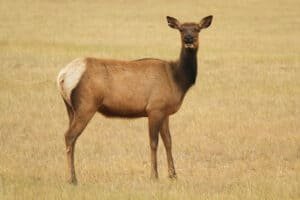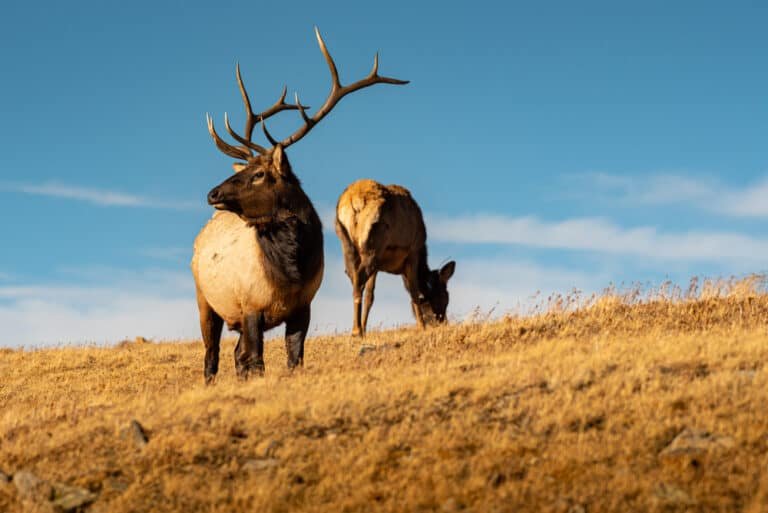Female Elk: 3 Fascinating Insights into Behaviors and Habitat
Elk holds a place of grandeur and mystique in the annals of natural history. These majestic creatures, also known as wapiti, are the second-largest species within the deer family, surpassed in size only by the moose. Native to North America and parts of Asia, all elk, especially female elk, embody strength, grace, and a remarkable ability to adapt to various ecosystems.
Brief Overview of the Elk Species
Elk have long captured the imagination of nature enthusiasts and wildlife admirers alike. With their imposing stature and impressive antlers adorning their heads during certain seasons, they command attention wherever they roam. Male elk, or bulls, are renowned for their spectacular antlers, used primarily for display during mating rituals and territorial disputes.
These magnificent appendages can span up to six feet across their broad beams, evoking awe in anyone fortunate enough to witness them. However, while much attention is often lavished upon male elk with their extravagant antlers and thunderous bugles echoing through forests during rutting season, the female elk embodies an equally fascinating story in elk biology.
Focus on Female Elk: A Fascinating and Often Overlooked Aspect of Elk Biology
Female elk, commonly called cows, play an essential role in sustaining population dynamics within elk herds. While not as visually striking as their male counterparts due to their lack of antlers (with rare exceptions), female elk possess an intricate beauty beyond superficial adornments. Their unique reproductive biology and maternal instincts make them captivating subjects worthy of exploration.
Furthermore, female elk exhibit remarkable social behaviors within herd structures that demonstrate a complex interplay between leadership roles and maintaining social cohesion. They are often responsible for guiding herds toward optimal habitats for feeding and calving while ensuring the well-being and safety of their offspring.
This article delves into the fascinating world of female elk, shedding light on their physical characteristics, reproductive cycles, maternal behaviors, and the crucial roles they play within elk herds. By uncovering the often overlooked aspects of female elk biology, we aim to deepen our understanding and appreciation of these remarkable creatures that contribute to the intricate tapestry of life in our natural world.
General Characteristics of Female Elk
Physical Appearance
Female elk, also known as cows, possess distinct physical characteristics that set them apart from their male counterparts. One notable difference lies in their size and weight.
While mature bull elk can reach an impressive height of around 5 to 5.5 feet at the shoulder and weigh up to 700-1000 pounds, female elk typically stand slightly shorter, averaging around 4 to 4.5 feet in height and weighing between 500-600 pounds on average. Regarding coat color and patterns, female elk exhibit various variations depending on factors such as geographic location and season.
Their coats are generally lighter in color compared to males, ranging from light brown to reddish-brown tones. This lighter coat coloration aids in camouflage within their natural habitats, making them less visible to potential predators.
Antlers or Lack Thereof in Females
One of the most striking differences between male and female elk is the presence or absence of antlers. Male elk, known as bulls, grow impressive antlers each year, which they display during mating season and combat with other males for dominance.
In contrast, female elk do not typically grow antlers. The absence of antlers in females is primarily due to differences in hormonal levels between the sexes.
Antler growth requires high testosterone levels, a hormone more prevalent in males during certain times of the year when their antler regeneration occurs. Female elk produce small amounts of testosterone but not enough to trigger significant antler growth.
Rare Instances of Female Elk with Antlers
Although uncommon, there have been instances where female elk have been observed growing antlers – a phenomenon that piques scientific interest. These rare occurrences can be attributed to hormonal imbalances that disrupt the typical hormonal patterns in females. One possible cause of female elk growing antlers is a condition called freemartinism.
Freemartinism occurs when a female calf has a male twin during pregnancy, and the hormones from the male fetus can affect the development of the female’s reproductive system and endocrine balance. This hormonal imbalance may result in antler growth in some cases.
Other factors like ovarian tumors or abnormalities in hormone production can also contribute to female elk developing antlers. While these instances are fascinating anomalies, they remain exceptions within the overall female elk population.

Reproduction and Maternal Behavior
Estrus cycle and mating rituals
Female elk, like many other mammals, experience an estrus cycle that determines their reproductive readiness. This cycle typically occurs once a year, lasting several weeks during autumn. Female elk exhibit distinct behavioral changes during this time to attract potential mates.
Known as the “rut,” this period is characterized by heightened aggressiveness and vocalization in females. They emit high-pitched calls called bugling to signal their readiness for mating.
Description of estrus behavior in female elk
During estrus, female elk display unique behaviors aimed at attracting males. They become more active, marking their territory with scent glands near the hind legs and releasing pheromones into the air.
These pheromones serve as chemical signals that communicate their fertility status to potential mates. Female elk also engage in physical displays such as head tossing, kicking, and even wrestling with other females to establish dominance and gain attention from males.
The role of pheromones in attracting males during mating season
Pheromones are crucial for communication between female elk and potential mates during mating. The females release These powerful chemical signals through urine and gland secretions when they are in estrus.
Male elk possess an incredibly sensitive sense of smell that allows them to detect these pheromones from long distances. This olfactory detection helps males locate receptive females within their territories or nearby herds.
Pregnancy, gestation, and birth
After successful mating during the rut, female elks undergo a gestation period lasting approximately 240-260 days. This extended duration ensures that calves are born at optimal times when food availability is abundant for nurturing offspring. The pregnant females seek out secluded areas within their habitat to give birth, often selecting dense forests or grassy meadows as birthing sites.
Duration of pregnancy in female elk
Among female elk, the duration of pregnancy ranges between 8 and 8.5 months. This extended period allows for the optimal growth and development of the fetus, ensuring its chances of survival upon birth.
Unique adaptations for giving birth in harsh environments
Female elk have remarkable adaptations that enable them to give birth and raise their young in challenging environments. One such adaptation is delayed implantation, where a fertilized egg remains dormant for several months before attaching to the uterine wall and initiating pregnancy.
This ensures that calves are born during favorable environmental conditions with plentiful food resources. Additionally, newborn elk calves possess an instinctual ability to stand within minutes after birth. They can walk shortly after that, aiding their ability to keep up with the herd and avoid predators from an early age.






